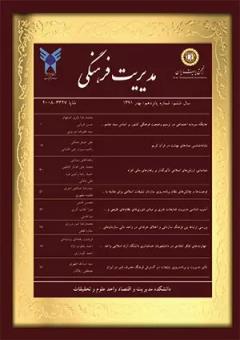گونه شناسی درجه تمرکزگرایی تصمیمگیری در ساختارهای فرهنگ محور(مُبلغ )
محورهای موضوعی : مدیریت فرهنگی
1 - استادیار، گروه مدیریت دولتی، واحد ملایر، دانشگاه آزاد اسلامی، ملایر، ایران (نویسنده مسئول).
کلید واژه: تمرکزگرایی, تمرکز و عدم تمرکز, گونه شناسی, ساختارهای فرهنگ محور(مبلغ) TISM,
چکیده مقاله :
زمینه و هدف: تصمیمگیری در سازمانها خصوصاً سازمانهای فرهنگ محور به عنوان یک فرآیند اساسی در تعیین سیاستهای فرهنگی است. این پژوهش، با هدف گونهشناسی و طراحی الگو درجه تمرکزگرایی تصمیمگیری در ساختارهای فرهنگ محور (مُبلغ) با رویکرد مدلسازی ساختاری تفسیری کل انجام شده است.
روشها: جمعآوری اطلاعات از منابع کتابخانهای و برای تحلیل دادهها از روش تحلیل محتوا و گونهشناسی که حدود 19 مقاله و کتاب؛ همراه با مصاحبه نیمهساختاریافته از جامعه آماری که تعداد هشت نفر اساتید دانشگاه آزاد اسلامی و مدیران وزارت فرهنگ و ارشاد اسلامی بودند، استفاده شد؛ در مرحله بعدی، با استفاده از رویکرد مدلسازی ساختاری تفسیری کل، سطوح جدید و روابط و علل روابط بین معیارها با استفاده از تعداد هشت پرسشنامههای زوجی تهیه شده از خبرگان تعیین شد.
یافتهها: در گونهشناسی تعداد پنج گونه نماینده با سه نوع کرانه به دست آمد و از مصاحبه خبرگان همراه با تحلیل محتوا ششمین گونه برای ساختارهای فرهنگ محور (مُبلغ) مشخص شد و در مرحله سوم با استفاده از روش TISM گونههای نماینده در چهار سطح مشخص گردیدند.
نتیجهگیری: ساختار ساده دارای بالاترین قدرت نفوذ و ساختار بوروکراسی حرفهای دارای بالاترین قدرت وابستگی است. ساختارهای فرهنگ محور (مُبلغ) دارای نیروی همافزایی از جمع پنج ساختار هستند و با یک نوع تمرکز نسبی یک قسمت مهمی به نام ایدئولوژی سازمانی را خلق مینمایند.
Context and Purpose: Decision-making in organizations, especially culture-oriented organizations, is a fundamental process in determining cultural policies. This research was carried out with the aim of typology and design of the model of the degree of Centralism of decision-making in culture-oriented structures with the approach of structural interpretive modeling. Methods: Collecting information from library sources and for data analysis using the method of content analysis and typology, which is about 19 articles and books; Along with the semi-structured interview, a statistical population of eight professors of Islamic Azad University and managers of the Ministry of Culture and Islamic Guidance was used; In the next step, using the overall interpretive structural modeling approach, new levels and relationships and the causes of relationships between criteria were determined using the number of eight paired questionnaires prepared from experts. Findings: In typology, the number of five representative species with three types of borders was obtained, and the sixth species was identified for culture-oriented structures from expert interviews along with content analysis, and in the third stage, representative species were determined at four levels using the TISM method. Conclusion: The simple structure has the highest influence power and the professional bureaucracy structure has the highest dependence power. Culture-oriented structures have synergistic power from the sum of five structures and create an important part called organizational ideology with a kind of relative concentration.

